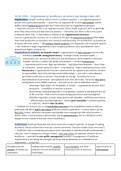31/10/2022 - Organisation in healthcare, structure and design trade-offs
Organisation = people working collectively for a common purpose → an organised group of
people with a particular purpose → properties: (a) organised life is often self-evident, and (b)
hidden behind golden bricks (people don’t think about how an organisation operates).
→ important, because: we live in an organised society (“from cradle to grave”), BUT we generally
know little about them and take them for granted → when they fail, there is often not a good
evaluation about why → often failure is related to the organisational structure.
Current organisational structures are a result from the past: (a) industrial revolution (1760-1830);
from hand production to machines, new chemical manufacturing, iron production, increased use
of steam and water power → (b) evidence-based medicine; new diagnostic and treatment options
→ has resulted in: larger organisations, more complex products, more specialisation, more
demand and higher productivity.
Organisations as machines: mechanistic model = organisations are task-oriented and work like
machines (scientific management theory = example of task-oriented model) →
organisations are: (a) aimed at efficiency and productivity, (b) formalised, central and
complex, and (c) in a stable and simple environment → involves bureaucracy.
→ organisational structure: high specialisation - rigid departmentalisation - clear chain
of command - narrow spans of control - centralisation - high formalisation (picture left).
- Bureaucracy = organisational structure characterised by regulatory procedures, division
of responsibility, hierarchy and impersonal relationships → principles: rationalisation
(procedures and rules to monitor what people are doing) - formality (focus on
standardisation of processes) - specialisation (one clear job to do) - hierarchy (top-down
management of low-skilled workers) - universal access, but no individual control.
- advantages: high degree of calculability of results → organisations become more
productive → possibility to monitor activities.
- disadvantage: dehumanising effect on employees, customers and patients (no say
in the process) - little room for human beings (powerless and meaningless) -
inflexible/rigid (due to many departments and subtasks) - inefficient and viscous
- differentiation and disintegration - limited goal rationality (= common purpose
to work for) - limited value morality.
→ hospitals are bureaucratic to: (a) standardise processes (clinical guideline practices and care
pathways), and (b) be highly specialised (different medical expertises) → counter effects: (a) the
hierarchy is slow, suffocates innovation and disables clear management directives (creates a
misfit culture of autonomous professionals), and (b) universal acces, but no individual control
(supply-driven instead of demand-driven healthcare).
Traditionally, health professionals had much autonomy (medical expertise, in charge of making
decisions), which isolated their work (no external autonomy: “butchers inspect their own meat”)
→ inefficient and no standards/procedures (care depended on individual health professionals) →
called for: more transparency and governance, voice and choice (of patients), demand-driven
healthcare → provided by new public management (market) = management of healthcare
organisations is becoming increasingly important and professionals are embedded in an
organisation → properties:
Strengthening the Making achievements tangible Accountability not solely Improvement of
position of healthcare (instead of secret professional horizontal (role of insurers). performance.
consumers. knowledge).
, → NPM creates a tension between the relation of professionalism and management.
- Professionalism = protected professionals treat cases → coordination, authority and
values: skills, norms, expertise, service ethic, quality, humanity → substantial component;
scientific knowledge, skills, experience and service ethics.
- Managerialism = well-run organisations deliver products for customers → coordination,
authority and values: hierarchy, markets, results, accountability, efficiency, profitability →
political component; professional association, controlled access,
autonomy and horizontal accountability.
→ example: Dutch regulated market competition = involves a regulated
healthcare market, transparency, accountability, demand and supply
driven, tension between management and professionalism → picture
right; insurance triangle = (linear logic of healthcare markets) based on
consumer choice, competition between insurance companies for
enrollees, negotiation for good quality and good price (between insurers
and healthcare providers).
Regulation of the healthcare market: (a) Ministry of Health, Welfare and Sport; monitors
adherence to rules and regulations, (b) Zorginstituut Nederland; decides what care is reimbursed
by insurers (approves a (evidence-based, cost-effective) set of treatments per diagnosis.
Market failure in healthcare:
- Healthcare is not a business.
- Insufficient competition to offer high quality care at the best price.
- No direct interaction between supply and demand → mediated by a third party.
- Increased accountability, bureaucracy is revisited (are the right numbers monitored?).
Organic model = (a) tasks, authority and routines are constantly redefined, (b) flat organisations,
(c) informal, decentralised and simple, and (d) complex and dynamic environment.
→ organisation structure: cross-functional teams - cross-hierarchical teams - free flow of info -
wide spans of control - decentralisation - low formalisation (picture left).
Organisational structure and design choices: distribution of power, lines of communication
(hierarchy), distribution of responsibilities (departementalisation), span of control (a manager
has several people in his/her team) → flatter organisations have a higher span of control,
because less layers so less people in a team).
- Formalisation = extent to which rules, procedures and other guides to action are written
and enforced → mechanic; highly formalised, organic; low formalisation.
- Centralisation = extent to which authority to make decisions is retained in top
management → mechanic; centralised, organic; decentralised.
- Complexity = number of different jobs and/or units within an organization → mechanic;
very complex, organic; simple.
→ design key trade-offs (that determine organisational structure):
centralisation: easier to implement, consistency with vs. decentralisation: more responsive to local
strategy, easier to achieve coordination and control, circumstances, opportunities for staff development, a
faster decision-making. sense of control is good for the staff’s motivation.
control (top-down) → who decides how work is done? vs. autonomy (bottom-up)





